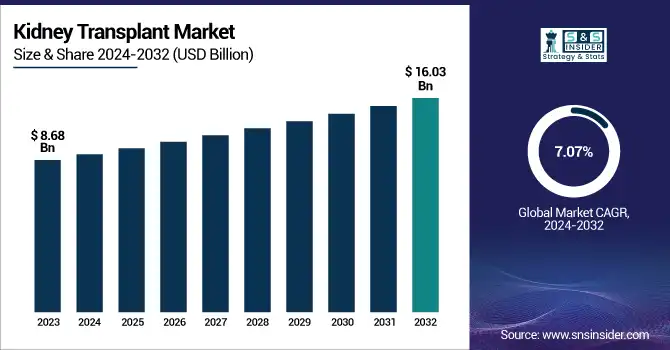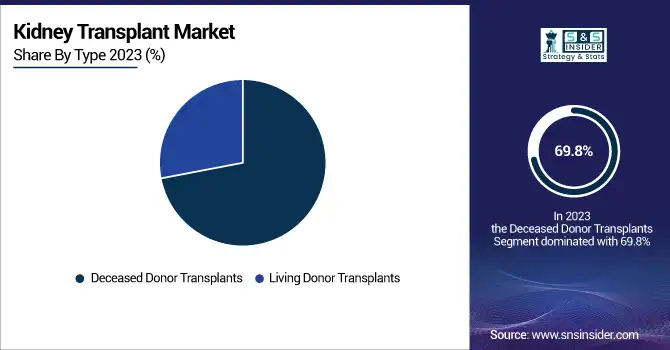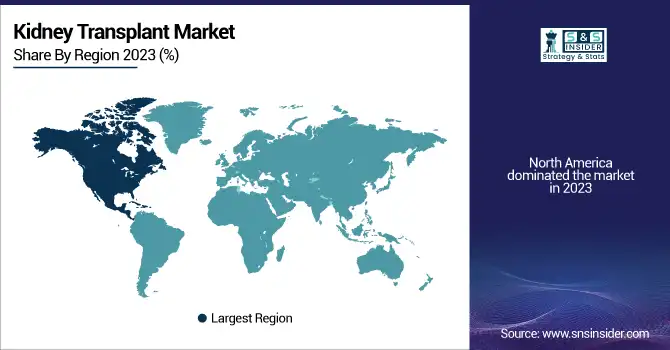Kidney Transplant Market Size Analysis:
The Kidney Transplant Market Size was valued at USD 8.68 billion in 2023 and is expected to reach USD 16.03 billion by 2032, growing at a CAGR of 7.07% over the forecast period of 2024-2032. This report identifies donor trends, comparing living and deceased donation between regions, based on cultural, medical, and regulatory considerations. The research examines transplant waiting lists and organ availability, with a focus on the continued mismatch between demand and supply that fuels the need for organ preservation technologies and alternative treatment options. Further, it reviews cost and reimbursement trends and illustrates regional differences in healthcare coverage, insurance programs, and financial aid schemes affecting patient access to transplantation. It also reviews post-transplant results and survival, examining innovations in immunosuppressive drugs, targeted therapy, and post-op care, improving long-term success rates.

To Get more information on Kidney Transplant Market - Request Free Sample Report
The U.S. Kidney Transplant Market was valued at USD 2.82 billion in 2023 and is expected to reach USD 4.76 billion by 2032, growing at a CAGR of 6% over the forecast period of 2024-2032. In the United States, the kidney transplant market is growing because of government initiatives, increasing organ donation awareness programs, and policy changes that seek to enhance reimbursement models and decrease transplant waiting times.
Kidney Transplant Market Dynamics
Drivers
-
Advancements in Transplant Techniques, Rising ESRD Cases, and Improved Organ Preservation Methods
The kidney transplantation market is fueled by the growing number of cases for end-stage renal disease (ESRD) and more than 850 million individuals across the globe living with chronic kidney diseases (CKD), creating a boom for transplant need. Improvements in transplant procedures, including robotic-assisted kidney transplants and minimally invasive donor nephrectomy, have resulted in advanced surgical results and improved patient recovery. In addition, advances in organ preservation techniques, such as normothermic machine perfusion (NMP), have prolonged donor kidney viability, lowering delayed graft function and rejection rates. Rising knowledge and public perception, along with government campaigns to encourage organ donation, e.g., Spain's record-breaking organ donation program with more than 48 donors per million population, have boosted transplant volumes. Moreover, progress in immunosuppressive drugs has enhanced graft survival, leading to higher post-transplant quality of life. The growing prevalence of paired and altruistic kidney donation programs is also propelling transplant volumes, overcoming compatibility problems, and shortening waiting periods.
Restraints
-
Shortage of Donor Organs, High Cost of Transplantation, and Ethical Concerns
Even with increasing demand for transplants, a severe shortage of donor kidneys is a key limitation, with more than 100,000 patients listed for kidney transplants in the U.S. but only approximately 25,000 transplants done per year. The expense of kidney transplantation, including surgery, post-transplant immunosuppressive drugs, and ongoing monitoring, is a limiting factor, especially among poor communities. A kidney transplant may cost as much as USD 400,000 in the United States, and it is, therefore, a financial burden for uninsured and underinsured patients. Ethical issues of organ trafficking and the sale of living donors are ongoing challenges of the market, with the illegal trade of organs accounting for 10% of all transplants globally, based on an assessment by the World Health Organization (WHO). Also, inequalities in access to transplantation, which are driven by socioeconomic status and racial disparities, hold the market back.
Opportunities
-
Emerging Xenotransplantation, Artificial Kidney Research, and Increasing Public-Private Partnerships
Xenotransplantation developments, such as recent pig-to-human kidney transplant successes, offer enormous opportunities in terms of solving the shortage of donor organs. Development in bioartificial kidneys, such as the Kidney Project's implantable artificial kidney, offers prospects to transform the treatment of kidney failure without donors. The growing use of blockchain and AI-based organ allocation platforms is increasing transparency and efficiency in matching donors and recipients, cutting waiting times. Also, increasing partnerships between governments and private agencies to finance kidney transplant programs is increasing access. For instance, the U.S. Advancing American Kidney Health Initiative is funding research aimed at enhancing transplantation rates and other therapies. More donations are being spurred by heightened public awareness campaigns and financial incentives for living donors, such as tax deductions and paid medical leave.
Challenges
-
Risk of Organ Rejection, Post-Transplant Complications, and Long-Term Immunosuppressant Dependency
One of the most significant challenges in kidney transplant is organ rejection, with acute rejection in 10-15% of the recipients within the first year. Although there has been progression in immunosuppressive therapy, long-term immunosuppressive drug exposure raises the risk of infections, cardiovascular diseases, and cancer. Transplant recipients also need lifelong immunosuppressant drugs, which may cost more than USD 10,000 per year, so long-term management is costly. Complications that occur post-transplantation, such as graft-versus-host disease (GVHD), delayed graft function (DGF), and nephrotoxicity, endanger patient outcomes and also contribute to a rise in hospitalization rates. Lack of adequately trained transplant surgeons and specialty transplant centers within developing countries also denies access to proper care, introducing inequalities into treatment access.
Kidney Transplant Market Segmentation Analysis
By Type
The deceased donor kidney transplant segment was the market leader with the highest revenue share at 69.8% in 2023. This leadership is mainly due to the growing supply of organs from brain-dead donors and the established infrastructure for deceased donor organ procurement and allocation. Moreover, improvements in organ preservation methods and government policies encouraging deceased organ donation have also contributed to the dominance of the segment.
The living donor transplant segment is also expected to grow at the fastest rate throughout the forecast period. The reasons include the growing popularity of minimally invasive donor nephrectomy methods, decreased wait times than for deceased donor transplants, and enhanced awareness for paired and altruistic kidney donation programs. Further, increased post-transplant survival rates and mounting support to living donors with monetary aid and health policies are propelling the segment's growth.

By Preservation Method
The static cold storage (SCS) segment dominated the market with a 42.6% share in 2023. Its popularity is attributed to its affordability, ubiquitous availability, and simplicity of use in maintaining donor kidneys. SCS has continued to be the gold standard technique for kidney preservation, especially in areas with limited access to sophisticated perfusion technologies. The technique's capacity to efficiently suppress metabolic activity and prolong organ viability has guaranteed its continued use in transplant centers across the globe.
Normothermic machine perfusion (NMP) is expected to increase at the highest rate over the next few years. The reason behind its growth is its potential to increase organ viability through continuous oxygen and nutrient supply, minimizing ischemic damage and enhancing post-transplant survival. The rise in the adoption of NMP is also bolstered by continuing clinical trials that have proven its efficiency in lowering delayed graft function and increasing the donor pool by using marginal kidneys.
Kidney Transplant Market Regional Insights
North America led the kidney transplant market in 2023 with established health infrastructure, a high rate of organ donation, and improved transplant methods. The United States alone conducts more than 25,000 kidney transplants every year, with the government actively promoting organ donation by implementing programs such as the National Organ Transplant Act (NOTA) and the Advancing American Kidney Health Initiative. The availability of new organ preservation technologies, including normothermic machine perfusion (NMP), further solidifies the region's market leadership. Favorable reimbursement policies and the presence of leading transplant centers are also fueling growth.
The European kidney transplant market is expected to grow at the highest rate in the forecast period, propelled by rising rates of organ donations and technological developments in transplants. Spain is the global organ donation leader, with more than 48 donors per million population, thanks to its extremely efficient organ procurement system. Germany, France, and the UK are also experiencing an increase in living and deceased donor transplants through government-initiated awareness campaigns and better donor registry systems. Advances in technology, such as machine perfusion methods and robotic-assisted transplants, are improving success rates and minimizing transplant rejection rates. Furthermore, positive health policies and transfrontier organ exchange schemes, including the Eurotransplant system, are enhancing transplant availability, such that Europe is the fastest-developing area of the kidney transplant market.

Get Customized Report as per Your Business Requirement - Enquiry Now
Kidney Transplant Market Key Players
-
Paragonix Technologies – KidneyVault Portable Renal Perfusion System
-
Organ Recovery Systems – LifePort Kidney Transporter
-
XVIVO Perfusion AB – Kidney Assist Transport
-
Organ Assist B.V. – Kidney Assist
-
TransMedics, Inc. – Organ Care System (OCS) Kidney
-
OrganOx Limited – Metra Normothermic Perfusion System
-
Bridge to Life Ltd – LifeCradle Heart Preservation Transport System
-
Waters Medical Systems – RM3 Renal Preservation System
-
Organ Transport Systems – LifePort Kidney Transporter
-
CareDx – AlloSure Kidney
Recent Developments in the Kidney Transplant Market
-
In April 2025, Massachusetts General Hospital (MGH) successfully performed its second pig kidney transplant in a living human, nearly a year after the first. Meanwhile, the US FDA has approved clinical trials, marking a significant advancement in xenotransplantation.
-
In April 2025, Vanderbilt Health successfully performed its first kidney transplant using the Paragonix KidneyVault Renal Perfusion System, an FDA-cleared organ preservation technology. This makes Vanderbilt the first in Tennessee and among the first in the Southeast to adopt this innovative system for kidney transport.
| Report Attributes | Details |
|---|---|
| Market Size in 2023 | USD 8.68 billion |
| Market Size by 2032 | USD 16.03 billion |
| CAGR | CAGR of 7.07% From 2024 to 2032 |
| Base Year | 2023 |
| Forecast Period | 2024-2032 |
| Historical Data | 2020-2022 |
| Report Scope & Coverage | Market Size, Segments Analysis, Competitive Landscape, Regional Analysis, DROC & SWOT Analysis, Forecast Outlook |
| Key Segments | • By Type [Living Donor Transplants, Deceased Donor Transplants (Donation after Brain Death (DBD), Donation after Circulatory Death (DCD)] • By Preservation Method [Static Cold Storage (SCS), Hypothermic Machine Perfusion (HMP), Normothermic Machine Perfusion (NMP)] |
| Regional Analysis/Coverage | North America (US, Canada, Mexico), Europe (Eastern Europe [Poland, Romania, Hungary, Turkey, Rest of Eastern Europe] Western Europe] Germany, France, UK, Italy, Spain, Netherlands, Switzerland, Austria, Rest of Western Europe]), Asia Pacific (China, India, Japan, South Korea, Vietnam, Singapore, Australia, Rest of Asia Pacific), Middle East & Africa (Middle East [UAE, Egypt, Saudi Arabia, Qatar, Rest of Middle East], Africa [Nigeria, South Africa, Rest of Africa], Latin America (Brazil, Argentina, Colombia, Rest of Latin America) |
| Company Profiles | Paragonix Technologies, Organ Recovery Systems, XVIVO Perfusion AB, Organ Assist B.V., TransMedics, Inc., OrganOx Limited, Bridge to Life Ltd, Waters Medical Systems, Organ Transport Systems, and CareDx. |

